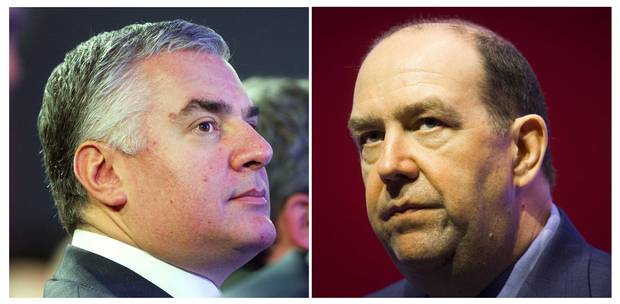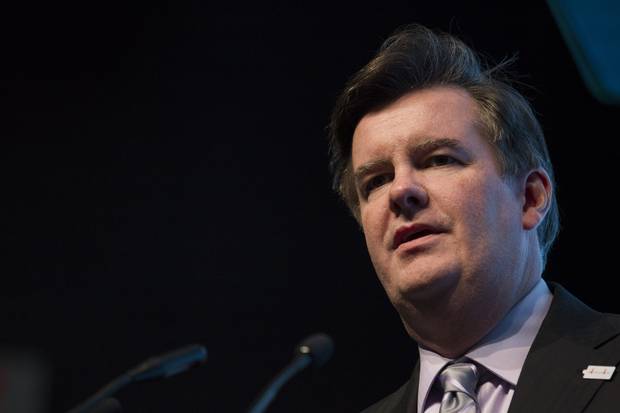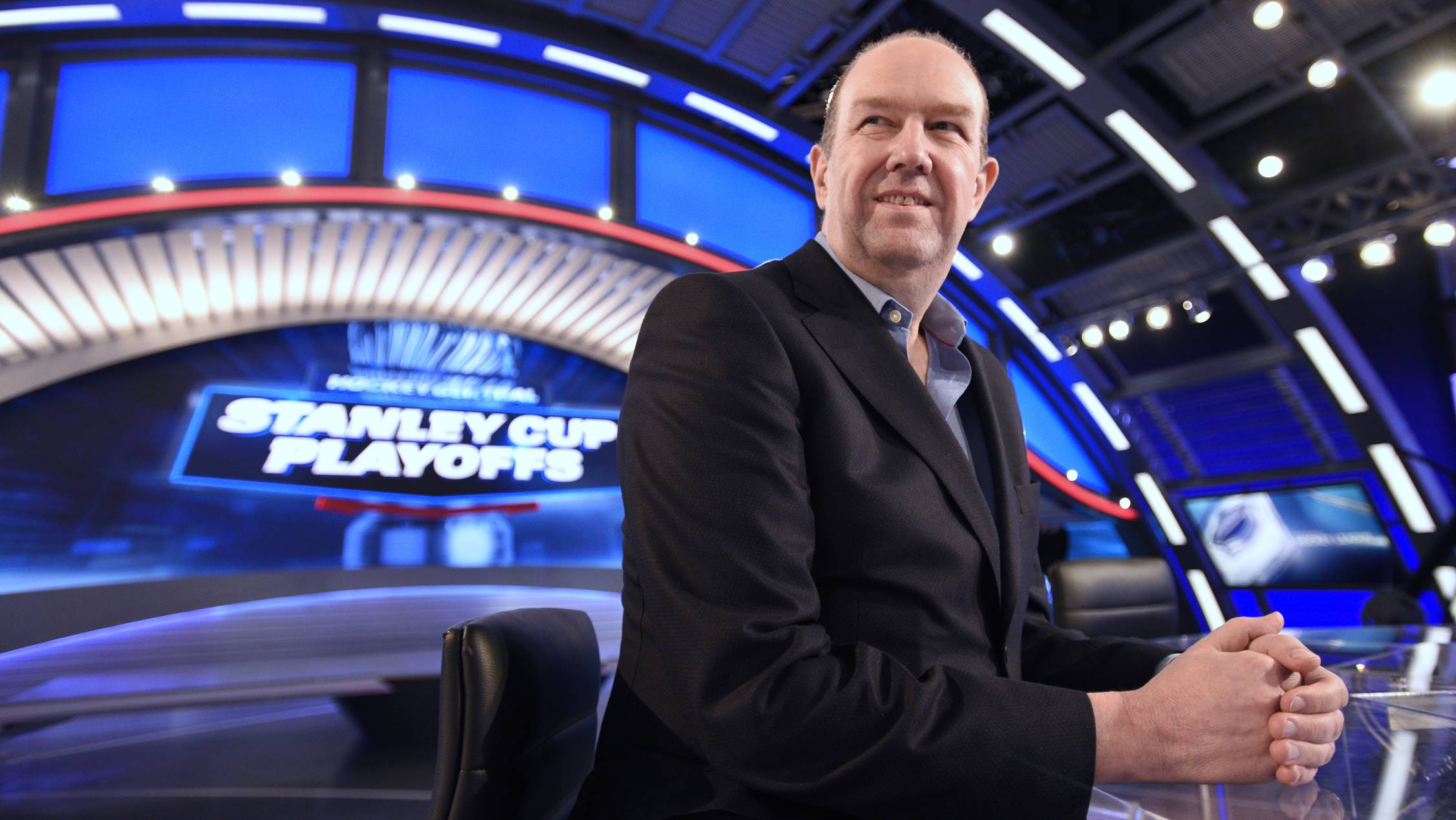Joe Natale, the one-time chief executive officer of Telus Corp., spent the last weeks of summer on his dock at Lake of Bays, Ont., pondering two of the biggest moves of his life.
One was, quite literally, a move: Mr. Natale and his wife, Melissa Martin, had decided to relocate from the affluent suburb of Oakville, Ont., where they'd raised three daughters, to a home in Toronto. The second, more difficult decision was what to do next in his career – and when to get on with it.
He had been shoved aside in August, 2015, after just 15 months in charge at Telus and left the company late last year, following a short transition period. After such a bruising public exit, Mr. Natale was telling friends and colleagues in the spring that he planned to spend the summer relaxing at his cottage, then consider his work options in the fall.
But in the meantime, someone with huge power began to show an interest in him: Edward Rogers, son of the late Ted Rogers, the founder of Rogers Communications Inc.
The Rogers empire had been run since late 2013 by Guy Laurence, a British transplant who had been hired from Vodafone Group Plc, and quickly embarked on a huge restructuring.
By this summer, he had reason to believe it was finally paying off. When Rogers announced second-quarter results in July, Mr. Laurence could point to 65,000 new wireless contracts – double what analysts predicted – and surging wireless service and Internet revenue. The stock price, $46 when Mr. Laurence arrived, rose to nearly $59 in August, a record high. And the third-quarter numbers announced this week included 114,000 net contract subscribers, the most in six years.
He might have thought that numbers like that would protect his job, despite his often-bumpy relationship with members of the Rogers family. How wrong.

Joe Natale, left, and the man he’s replacing at the helm of Rogers, Guy Laurence.
Ben Nelms/Mark Blinch/Reuters
On Sunday, after a hastily called board meeting, Mr. Laurence was summoned to the Rogers head office and fired by Alan Horn, the chairman of the board. By late Sunday evening, stunned senior executives were being briefed on a confidential call: Mr. Laurence was out, Mr. Horn was in as interim CEO, to replaced soon by Mr. Natale.
What happened?
Sources close to the company say that Mr. Laurence's undoing was his testy relationship with the children of Ted Rogers, and his blithe attempt to run the business as though it were a regular public company – and not one controlled by a sometimes-fractious family with a deep desire to protect the founder's legacy.
In fact, sources confirmed that the Rogers board had its eye on Mr. Natale ever since he left Telus last year. The long courtship to land him began in earnest about six months ago, with efforts to sound him out about the idea.
Support for dumping Mr. Laurence in favour of Mr. Natale within the company's board grew too, driven by Edward Rogers, one of the most active members of the Rogers family, along with Mr. Horn and vice-chairman Phil Lind, longtime Rogers loyalists who were key players in its rise to become the country's largest wireless provider.
Mr. Natale likely won't join the company until some time in 2017 because of a non-compete agreement with Telus that is believed to expire next summer. But when he does, he'll find it an easy commute: on Sept. 21, he closed a deal to purchase a house on one of the more desirable streets in Rosedale, a convenient five-minute drive from the complex of Rogers buildings at Bloor Street East and Jarvis Street.
It is not the first time that Rogers has had a messy succession. In 2013, Nadir Mohamed, the man who'd taken over after Ted Rogers's death in 2008, stepped down unexpectedly with no heir apparent in sight.
Thus began a months-long search for a new CEO that eventually brought Mr. Laurence to Canada. The hiring was championed by Edward Rogers, one of four Rogers family members on the board.

Edward Rogers, shown in 2014.
Chris Young for The Globe and Mail
Mr. Laurence's first move was to crisscross the country on a "listening tour." He did individual interviews with dozens of executives and senior managers and heard from many more through a written survey of "seven questions" about how the company could improve. Mr. Laurence documented his progress with words and photos on "Guy's blog" on the company intranet site.
One of the last stops on his listening tour, in the spring of 2014, was a visit to Loretta Rogers, Ted Rogers's widow. It's believed that in that meeting he explained the rationale behind his plan to remove her children, Edward Rogers and Melinda Rogers, from their operating roles in the company – a delicate task that had broad support in the company's senior ranks. (Melinda Rogers was senior vice-president involved in corporate strategy while Edward Rogers held an executive vice-president role.)
Some close to the company say this move, and the way Mr. Laurence handled it, was the start of ongoing friction between the CEO and key family members, which would grow more acrimonious as time went on.
Still, Mr. Laurence seemed unaware the axe might be about to fall until the day that it did – perhaps thinking the company's gains in share price and wireless subscribers would insulate him from criticism.
While there was no obvious trigger or definitive clash with the family that sealed Mr. Laurence's fate last week, key directors in charge of wooing Mr. Natale worried that he was in danger of slipping away. Sources say that in addition to the Rogers job, he was considering an investment in a smaller company where he would take an operational role.
"He had options, too. So we had to move," said Mr. Lind said in an interview this week.
Mr. Laurence, Mr. Natale, Mr. Horn and Edward Rogers declined to grant interviews.
The role will give Mr. Natale a second chance to run one of Canada's Big Three wireless companies – under different circumstances than he'd been afforded at Telus. Mr. Natale was promoted to CEO there in 2014 – in part to keep him on the Telus team and away from Rogers – but former CEO Darren Entwistle remained a domineering presence, still actively involved in operations as executive chairman of the board.
Mr. Natale first joined Telus in 2003 and had ambitions to sit in the CEO's chair from the beginning. After a stint heading up the company's enterprise and small and medium-size business division, he took over the crucial wireless business following the departure of George Cope and others for BCE Inc.
Mr. Natale, whose leadership style is based on building good teams and encouraging the talents of his staff, thrived in the role. He spearheaded the development of its "customers first" revamp of customer experience, an idea some telecom veterans questioned at the time, warning it could erode revenues. But it paid off through reduced rate of customer turnover and lower marketing costs and has now become close to gospel at Telus, copied elsewhere in the industry.
Mr. Laurence made turning around Rogers's reputation for poor service his first priority when he arrived. He frequently recounts a story of arriving at customs when he first came to Canada. While waiting for the agent to stamp his work visa, he revealed where he was going to work, and the agent replied, "Welcome to Canada. Your service sucks."
Mr. Laurence instituted a new way of tracking progress on customer service that became ever-more important at the company – and tied to performance bonuses – over the last two years: Net promoter score. Customers are asked to rate their experience and after subtracting the ratings of "detractors" from those of "promoters," a score is produced on a scale from minus–100 to plus-100. The higher the score, the more likely it is that customers would recommend the company or its services to others.
Rogers began tracking two types of NPS, one for front-line employees – call centre operators, field technicians and store agents – and one for the overall relationship people have with the company. Mr. Laurence and the new team of executives he recruited implemented new measures like an easier-to-understand bill, streamlined cellphone, Internet and cellphone packages, and a simple (and relatively affordable) international wireless roaming package. Rogers has been investing $100-million per year on customer service improvements and says it has made encouraging progress on the front-line NPS.
But improving overall perception of the company has been more difficult. At one point part way through Mr. Laurence's tenure, the NPS score for Rogers as a whole was minus–27, according to one source close to the company. (Rogers does not publicly disclose its scores.) And although Mr. Laurence had set an ambitious goal to turn the score positive, and Rogers says it has made progress on the NPS metric, it has been harder to repair the company's brand than many of its executives had hoped.
During a town hall-style meeting with hundreds of the top managers at Rogers on Tuesday, Edward Rogers and Mr. Horn reassured employees that the company was doing well, making strides on wireless subscribers and Internet sales, and that Mr. Laurence's sudden departure was not an indictment of their work.
But the pair also suggested that more work was needed on customer service as well as Rogers's outdated cable television product. And the meeting cast doubt on the future of some of Mr. Laurence's pet initiatives – such as Sharespace, a high-priced plan to renovate the Rogers's offices with open seating instead of cubicles to encourage more teamwork and collaboration.
Many believe Mr. Natale will be able to apply his experience driving customer relations at Telus to his new job at Rogers. While at Telus, Mr. Natale was also closely involved in the launch of its IPTV (Internet protocol television) product known as Optik TV, which quickly became a headache for western cable rival Shaw Communications Inc. as Telus gobbled up television market share. IPTV offers advantages like the ability to pause and restart on different TVs and watch content on a range of devices plus navigation menus that can browse content on services like Netflix as well as conventional TV stations.
Rogers faces the same challenge in the east, primarily due to competition from BCE's Fibe TV, and its own plan to roll out a next-generation IPTV service developed in-house has been in the works for more than five years and plagued by delays. Mr. Laurence prided himself on a reputation for delivering results on time, without excuses, but the project has taken far longer than expected to complete.
"Yes, I think it's very clear to everyone that our TV product is not as good as it needs to be and there are better products out there," Mr. Laurence admitted during an investor conference in September, adding that the company has a product it is proud of but still not quite ready to launch. "We'll introduce it in a beta format towards the end of the year… but I'm not promising that. We'll launch it when we're ready. It looks great, it is great, it will be great."
But IPTV, along with his other projects, will now remain unfinished business for Mr. Laurence, as Mr. Horn takes over as interim CEO. Mr. Natale signed a two-year non-compete agreement with Telus and while a source close to the Telus board says Rogers is currently negotiating with the company over an earlier end to the deal, it is unclear when he will be able to join the Toronto company and it could be as late as next summer.
"As with any leadership change, we expect Natale will need several months to fully learn the organization… adding to the timeline is Natale's non-compete commitment to Telus, on which we believe Rogers is currently seeking legal clarity," Barclays Capital analyst Phillip Huang wrote in a report this week.
"In any event, 2017 is now poised to be another year of transition for Rogers, following several years of disruptive changes," Mr. Huang added, referencing the CEO change in 2013 as well as the company's move to a wireless strategy that preferred higher-value customers over high volumes of subscribers (which saw Rogers report several quarters of low and even negative subscriber additions). "As such, we continue to stay on the sidelines despite Rogers' improving momentum."
Rogers has also paid a heavy price for its apparently fickle approach to leadership, at a time when it has slashed hundreds of jobs and paused dividend hikes amid concerns over cash flow and debt leverage. It paid Mr. Mohamed $26.8-million in 2013, a sum that included a $17.1-million retirement package, and has paid Mr. Laurence $32.9-million over the past three years, including about $10-million in cash signing bonuses and stock-based compensation to recruit him away from Vodafone.
In addition to that, Rogers' corporate filings indicate the company must pay Mr. Laurence $16-million in the event of termination without cause.
With files from Andrew Willis
